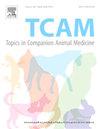Prevalence and molecular characterization of parvoviruses in dogs and domestic cats in Guangxi, China: new emergence of CPV-2c in cats
IF 1.3
3区 农林科学
Q2 VETERINARY SCIENCES
引用次数: 0
Abstract
Feline panleukopenia virus (FPV) and its canine-adapted derivative, canine parvovirus (CPV), cause severe gastroenteritis in their respective hosts. To investigate the molecular epidemiology and cross-species transmission of these viruses, we conducted a large-scale surveillance study in Guangxi, China. From 1257 fecal samples from dogs (n = 552) and domestic cats (n = 705), we obtained 86 VP2 gene sequences. Phylogenetic analysis revealed three CPV subtypes circulating in dogs: New-CPV-2a (5.3 %, 3/57), New-CPV-2b (1.8 %, 1/57), and the predominant CPV-2c (93.0 %, 53/57), all clustering with contemporary Asian strains. These variants exhibited 17 amino acid substitutions in the VP2 capsid protein, including key residues associated with host adaptation and antigenic variation. Crucially, we detected five CPV-2c strains in domestic cats that contained the S564N and G568A mutations in VP2-residues previously implicated in feline host adaptation. While FPV-G3 (79.2 %) remained predominant in cats, the emergence of CPV-2c in felines demonstrates active cross-species transmission. Our study demonstrates the complex molecular epidemiology of parvoviruses in southern China and documents the expanding host range of CPV-2c. These findings underscore the need for continuous surveillance using whole-genome sequencing to track viral evolution and inform vaccine development.
中国广西犬和家猫细小病毒的流行和分子特征:CPV-2c在猫中的新出现
猫泛白细胞减少病毒(FPV)及其犬类衍生物犬细小病毒(CPV)在各自的宿主中引起严重的胃肠炎。为了研究这些病毒的分子流行病学和跨种传播,我们在中国广西进行了大规模的监测研究。从1257份狗(552份)和家猫(705份)的粪便样本中,我们获得了86条VP2基因序列。系统发育分析显示犬中流行的三种CPV亚型:New-CPV-2a(5.3%, 3/57)、New-CPV-2b(1.8%, 1/57)和主要的CPV-2c(93.0%, 53/57),均与当代亚洲毒株聚集。这些变异在VP2衣壳蛋白中显示了17个氨基酸的替换,包括与宿主适应和抗原变异相关的关键残基。至关重要的是,我们在家猫中检测到5种CPV-2c菌株,它们含有先前与猫宿主适应有关的vp2残基中的S564N和G568A突变。虽然FPV-G3(79.2%)在猫中仍占主导地位,但CPV-2c在猫中的出现表明了活跃的跨物种传播。我们的研究揭示了中国南方细小病毒复杂的分子流行病学,并记录了CPV-2c宿主范围的扩大。这些发现强调了使用全基因组测序来跟踪病毒进化并为疫苗开发提供信息的持续监测的必要性。
本文章由计算机程序翻译,如有差异,请以英文原文为准。
求助全文
约1分钟内获得全文
求助全文
来源期刊

Topics in companion animal medicine
农林科学-兽医学
CiteScore
2.30
自引率
0.00%
发文量
60
审稿时长
88 days
期刊介绍:
Published quarterly, Topics in Companion Animal Medicine is a peer-reviewed veterinary scientific journal dedicated to providing practitioners with the most recent advances in companion animal medicine. The journal publishes high quality original clinical research focusing on important topics in companion animal medicine.
 求助内容:
求助内容: 应助结果提醒方式:
应助结果提醒方式:


